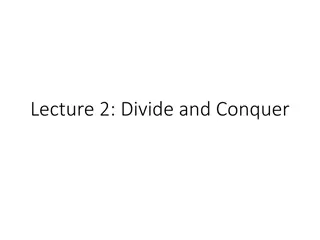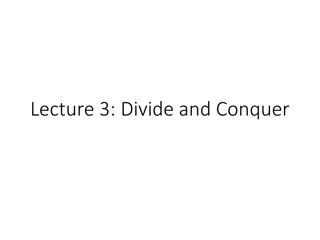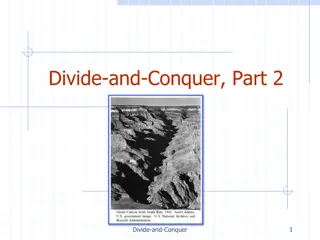Decrease and Conquer Algorithms: A Guide to Understanding Various Techniques
Explore decrease and conquer algorithms such as binary search, exponentiation, multiplication strategies, search in binary search trees, median finding, and game theories like Nim. Learn about tackling challenges by decreasing parameters with illustrative examples and problem-solving approaches.
Download Presentation

Please find below an Image/Link to download the presentation.
The content on the website is provided AS IS for your information and personal use only. It may not be sold, licensed, or shared on other websites without obtaining consent from the author.If you encounter any issues during the download, it is possible that the publisher has removed the file from their server.
You are allowed to download the files provided on this website for personal or commercial use, subject to the condition that they are used lawfully. All files are the property of their respective owners.
The content on the website is provided AS IS for your information and personal use only. It may not be sold, licensed, or shared on other websites without obtaining consent from the author.
E N D
Presentation Transcript
Decrease by a constant factor Decrease by a variable amount A FEW LEFTOVER DECREASE-AND- CONQUER ALGORITHMS
Decrease by a Constant Factor Examples that we have already seen: Binary Search Exponentiation (ordinary and modular) by repeated squaring Multiplication la Russe (The Dasgupta book that I often used for the first part of the course calls it "European" instead of "Russian") Example 11 13 5 26 2 52 1 104 143 Then strike out any rows whose first number is even, and add up the remaining numbers in the second column.
Fake Coin Problem We have n coins All but one have the same weight One is lighter We have a balance scale with two pans. All it will tell us is whether the two sides have equal weight, or which side is heavier What is the minimum number of weighings that will guarantee that we find the fake coin? Decrease by factor of two?
Decrease by a variable amount Search in a Binary Search Tree Interpolation Search See Levitin, pp190-191 Also Weiss, Section 5.6.3
Median finding Find the kth element of an (unordered) list of n elements Start with quicksort's partition method Informal analysis
One Pile Nim There is a pile of n chips. Two players take turns by removing from the pile at least 1 and at most m chips. (The number of chips taken can vary from move to move.) The winner is the player that takes the last chip. Who wins the game the player moving first or second, if both players make the best moves possible? It s a good idea to analyze this and similar games backwards , i.e., starting with n = 0, 1, 2,
Graph of One-Pile Nim with m = 4 1 6 7 2 10 5 0 8 3 9 4 Vertex numbers indicate n, the number of chips in the pile. The losing position for the player to move are circled. Only winning moves from a winning position are shown. Generalization: The player moving first wins iff n is not a multiple of 5 (more generally, m+1); The winning move is to take n mod 5 (n mod (m+1)) chips on every move.
Multi-Pile Nim There are multiple piles of chips. Two players take turns by removing from any single pile at least 1 and at most all of that pile's chips. (The number of chips taken can vary from move to move) The winner is the player that takes the last chip. What is the winning strategy for 2-pile Nim? For the general case, consider the "Nim sum", x y, which is the integer obtained by bitwise XOR of corresponding bits of two non-negative integers x and y. What is 6 3?
Multi-Pile Nim Strategy Solution by C.L. Bouton: The first player has a winning strategy iff the nim sum of the "pile counts" is not zero. Let's prove it. Note that is commutative and associative. Also note that for any non-negative integer k, k k is zero.
Multi-Pile Nim Proof Notation: Let x1, ,xn be the sizes of the piles before a move, and y1, ,yn be the sizes of the piles after that move. Let s = x1 xn, and t = y1 yn. Observe: If the chips were removed from pile k, then xi = yi for all i k, and xk > yk . Lemma 1: t = s xk yk . Lemma 2: If s = 0, then t 0. Lemma 3: If s 0, it is possible to make a move such that t=0. [after proof, do an example]. Proof of the strategy is then a simple induction. (do this one with a partner. Great HW or exam question.)
Josephus problem - background Flavius Josephus was a Jewish general and historian who lived and wrote in the 1st century AD Much of what we know about 1st century life in Israel (and the beginnings of Christianity) before and after the Roman destruction of the Jewish temple in 70 AD comes from his writings The "Josephus problem" is based on an odd suicide pact that he describes He and his men stood in a circle and counted off Every other person (or every third person, accounts vary) was killed The last person was supposed to kill himself He must have been the next-to-last person! When it got down to two people, he persuaded the other person that they should surrender instead http://en.wikipedia.org/wiki/Josephus























